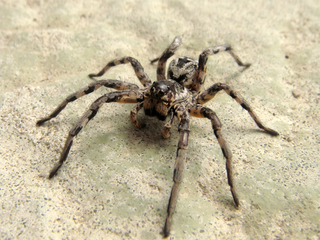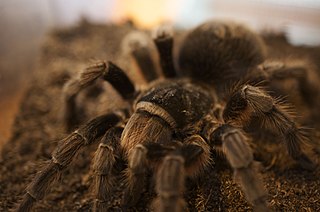Tarantella is a group of various southern Italian folk dances originating in the regions of Calabria, Campania and Puglia. It is characterized by a fast upbeat tempo, usually in 6
8 time, accompanied by tambourines. It is among the most recognized forms of traditional southern Italian music. The specific dance-name varies with every region, for instance Sonu a ballu in Calabria, tammurriata in Campania, and pizzica in Salento. Tarantella is popular in Southern Italy, Greece, Malta, and Argentina. The term may appear as tarantello in a linguistically masculine construction.

Lycosa tarantula is the species originally known as the tarantula, a name that nowadays in English commonly refers to spiders in another family entirely, the Theraphosidae. It now may be better called the tarantula wolf spider, being in the wolf spider family, the Lycosidae. L. tarantula is a large species found in southern Europe, especially in the Apulia region of Italy and near the city of Taranto, from which it gets its name.

Icius is a genus of jumping spiders described by Eugène Simon in 1876, belonging to the Order Araneae, Family Salticidae.

Pseudicius is a genus of the jumping spiders first described by Eugène Simon in 1885. The name is combined of Greek pseudo "false" and the salticid genus name Icius. The small genus Wesolowskana should possibly be included in this genus. There is some dispute whether Afraflacilla is a distinct genus or should be included in Pseudicius. Festucula and Marchena are other close relatives, these genera form a monophyletic group.

Thyene is a genus of jumping spiders that was first described by Eugène Louis Simon in 1885. It is a junior synonym of Mithion, and senior synonym of Brancus, Paramodunda and Gangus.

Lycosa is a genus of wolf spiders distributed throughout most of the world. Sometimes called the "true tarantula", though not closely related to the spiders most commonly called tarantulas today, Lycosa spp. can be distinguished from common wolf spiders by their relatively large size. This genus includes the European Lycosa tarantula, which was once associated with tarantism, a dubious affliction whose symptoms included shaking, cold sweats, and a high fever, asserted to be curable only by the traditional tarantella dance. No scientific substantiation of that myth is known; the venom of Lycosa spiders is generally not harmful.

Trichonephila edulis is a species of large spider of the family Nephilidae, formerly placed in the genus Nephila. It is referred to by the common name Australian golden orb weaver. It is found in Indonesia from Java eastwards, Papua New Guinea, Australia, northern New Zealand, and New Caledonia.
In the 10th edition of Systema Naturae, Carl Linnaeus classified the arthropods, including insects, arachnids and crustaceans, among his class "Insecta". Wingless arthropods were brought together under the name Aptera.
Alfred Frank Millidge was a British arachnologist who wrote several works on spiders. One of his best-known might be British Spiders, volumes I and II, which he co-wrote with G. H. Locket. In 1983, he became the first person to describe the spider species Walckenaeria crocea.

Araneus viridiventris is a species of spiders described by Takeo Yaginuma in 1969, found in China, Taiwan, India, and Japan. A. viridiventris is included in the genus Araneus in the family Araneidae. No subspecies are listed.
Acragas erythraeus is a species of jumping spider in the genus Acragas. The scientific name of this species was first published in 1900 by Simon. These spiders are found in Brazil.
Acragas fallax is a species of jumping spider in the genus Acragas. The scientific name of this species was first published in 1896 by Peckham & Peckham. These spiders are usually easily found in Panama.
Acragas humaitae is a species of jumping spider in the genus Acragas. The scientific name of this species was first published in 1978 by Bauab & Soares. These spiders are usually easily found in Brazil.

Chiasmopes is a genus of nursery web spiders that was first described by P. Pavesi in 1883.

Pardosa pullata is a species of spiders from genus Pardosa in the family Lycosidae. It was described by Clerck, in 1757.
Hogna pseudoceratiola is a species of wolf spider in the genus Hogna of the family Lycosidae. It was described for the first time by Wallace in 1942.

Anoteropsis hilaris, commonly referred as the garden wolf spider or the grey wolf spider, is a species of wolf spider that is endemic to New Zealand.

Grammostola alticeps is a New World spider in the tarantula family (Theraphosidae). It is endemic to Uruguay, Paraguay, and Brazil.
Halocosa is a genus of wolf spiders first described by G. N. Azarkina and L. A. Trilikauskas in 2019. As of December 2021 it contains only three species: H. cereipes, H. hatanensis, and H. jartica. The type species, Halocosa cereipes, was originally described under the name "Lycosa cereipes".

Lycosa erythrognatha is a species of spider from the genus Lycosa. The species was originally described in 1836. It is the only spider known to feed on Rhinella ornata.











